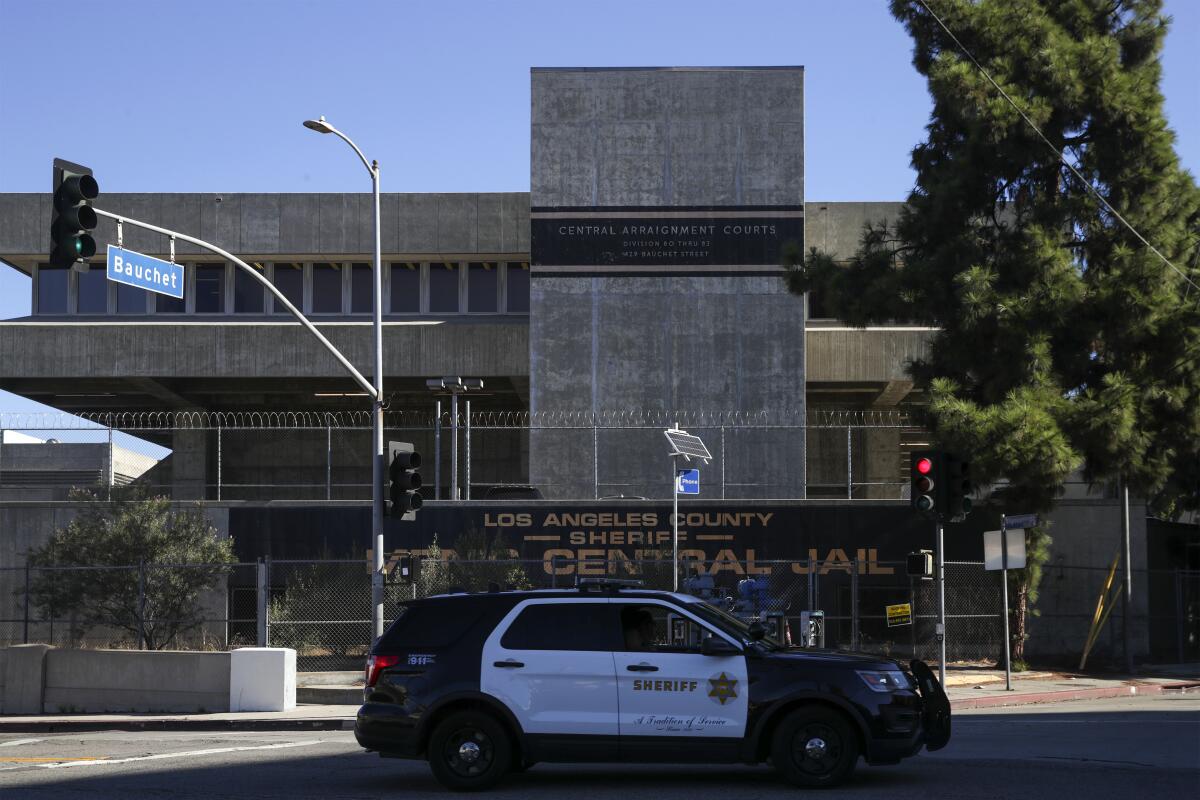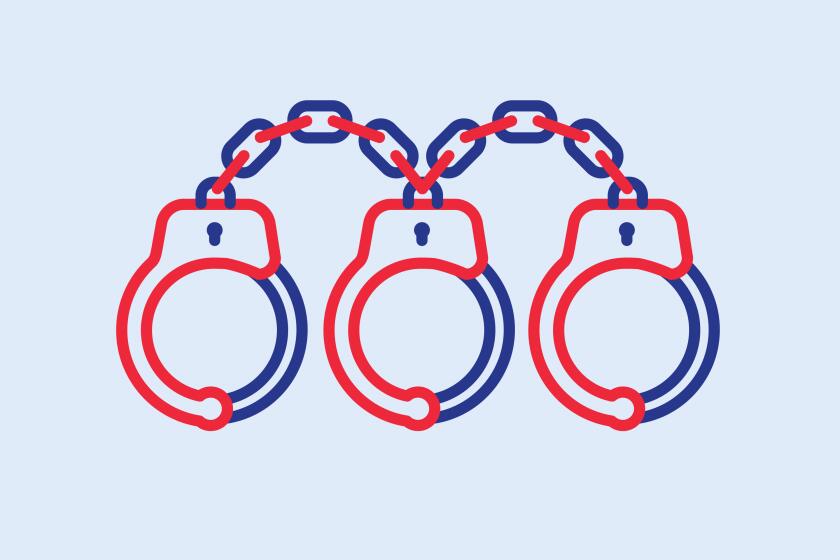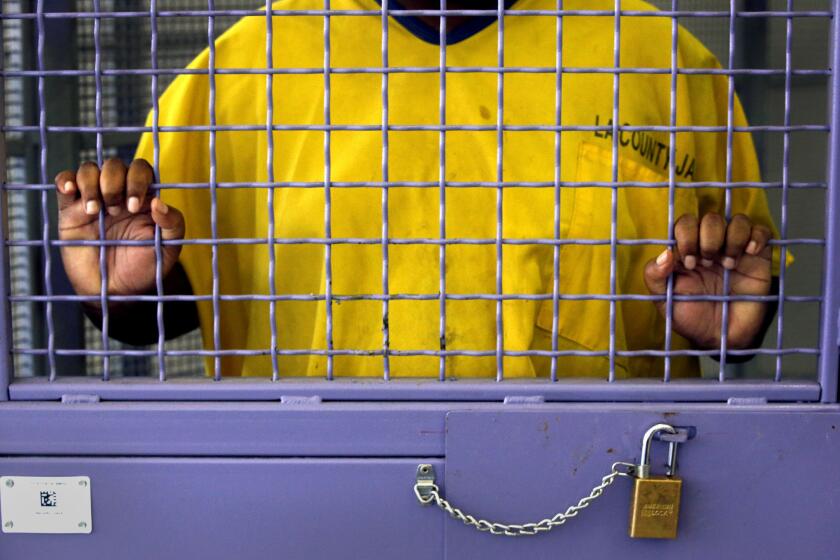‘Pendulum has swung’: Supervisors signal shift on Men’s Central Jail closure plan

In the summer of 2019, justice reformers celebrated because the Los Angeles County Board of Supervisors scrapped a controversial $1.7-billion plan to replace the county’s oldest lockup — the dungeon-like Men’s Central Jail on Bauchet Street — with a jail-like mental health facility.
Buoyed by a rising tide of prison reforms across the country, county leaders decided to focus instead on decreasing the jail population by creating more alternatives to incarceration. The new goal would be to close Men’s Central Jail without building a replacement.
Five years later, there are roughly 5,000 fewer inmates — but Men’s Central Jail is still open. And at the state level, the tides are changing, as voters are set to consider increasing the penalties for low-level theft and some drug crimes, both moves that could balloon the jail population.
Amid that backdrop, the board appears to be rethinking its no-new-jails strategy.
This measure asks voters to change parts of Proposition 47, a controversial ballot initiative passed in 2014 that turned some nonviolent felonies into misdemeanors.
“The pendulum has swung,” Supervisor Holly Mitchell said at Tuesday’s board meeting. “We keep saying: When are you closing Men’s Central Jail? I think there needs to be an ‘and what are we building or creating for this population that perhaps pretrial, diversion, community settings won’t match.’”
It’s a question supervisors have been unwilling to entertain for the last five years, arguing they could shrink the jail population to zero without a new facility. But the board publicly changed its tone after Sheriff Robert Luna and his top jail official told them three-quarters of county inmates are facing charges too serious for diversion programs.
“I felt like we finally broke through the discussion of why it’s needed and justification as to why it’s needed, because numbers don’t lie,” said Supervisor Kathryn Barger in an interview. “A replacement has to take place.”
What the county might replace the jail with — or where it would site a replacement — remains unclear.
To some justice reformers, the recent change of tone comes as a profound disappointment.
Claire Simonich, associate director of the nonprofit Vera California, questioned the department’s claim that 75% of people in the jails couldn’t be diverted, as well as the notion that a new facility would solve the problems currently plaguing the county’s lockups.
“Men’s Central Jail is decrepit,” she said. “Building another jail won’t address many of the problems and concerns that we see at Men’s Central Jail — like overdose deaths, inhumane treatment and inadequate mental healthcare.”
****
When Men’s Central Jail opened five decades ago, county leaders hoped the new capacity would end overcrowding and, in the process, improve worsening conditions in local lockups. Instead, the facility has given rise to federal lawsuits, aggressive deputy gangs, a sweeping scandal that landed a former sheriff in prison and a persistent string of complaints from inmates, oversight officials and community members.
But county leaders faltered in response. Three years after agreeing the county needed to build a new jail, the board in 2018 approved a $2.2-billion plan to do that — by tearing down the existing facility and replacing it with a rehabilitation-focused Consolidated Correctional Treatment Facility.
Setting a future course for the troubled Los Angeles County jail system, the Board of Supervisors on Tuesday approved a plan to move at least 1,000 mentally ill offenders out of lockups and voted to build a state-of-the-art jail focused on mental health treatment.
The following year, the board changed course and instead greenlit a $1.7-billion project dubbed the Mental Health Treatment Center. Approved in a 3-2 vote, the planned facility would have been overseen primarily by the Department of Health Services instead of the Sheriff’s Department, though a limited number of deputies would have provided security.
“It’s still a jail,” Supervisor Hilda Solis said at the time, opposing the plan. “It’s still walls. It’s still preventing people from having freedom, the possibility of even rehabilitation.”
A few months later, the board scrapped the idea and started over, eventually embracing a “care first, jails last” philosophy paired with the goal of tearing down the decaying jail and not building a replacement. In 2021, the board approved an ambitious plan to decrease the number of people in custody by several thousand so the county could shut down the facility bit by bit before closing it completely.
But the planned closure date — in early 2023 — came and went, and the jail remains open. Last year, the board floated a motion outlining several recommendations to decrease the population but offering no concrete timeline for closure.
The district attorney’s office explained the move in a memo, saying prosecutors couldn’t tell whether the violence was intentional.
Meanwhile, conditions have not improved. The county is still grappling with several longstanding class-action lawsuits alleging abuse, poor conditions and inadequate mental healthcare behind bars. The jail death rate has risen sharply in recent years.
And this year, inspections by the county’s Sybil Brand Commission have revealed mold, rats, fires, broken toilets, sink drains filled with “small black worms” and cells covered in feces. In May, two inspectors found a large group of jailers watching a “sexually explicit” video instead of tending to a seemingly suicidal inmate who’d hung a rudimentary cloth noose in his cell.
****
The tenor of last week’s board meeting signaled yet another change of direction in the county’s response.
Though the agenda called for a discussion about the deteriorating conditions at Men’s Central Jail, the conversation quickly shifted to plans for the facility’s future.
Luna told supervisors he wasn’t sure the county could ever decrease its incarcerated population enough to close Men’s Central Jail without a replacement, in part because officials estimate so many inmates are facing charges that are too violent or serious for diversion programs. Instead, he suggested building what he called the “Care First Treatment Campus,” which he said wouldn’t necessarily be run by sheriff’s deputies.
Barger, the board’s lone Republican, seized on the suggestion as a path forward that could garner support from her more progressive counterparts.
“Men’s Central Jail needs to be torn down no matter what,” Barger said at the meeting. “The fact that it doesn’t have to be a sheriff-run facility … maybe you just opened up a new door in terms of finally doing something.”
Solis, historically one of the loudest opponents of a new jail on the board, was adamant that, if another facility was built, it should not be in her area, which she said was already overwhelmed with carceral facilities, including Men’s Central Jail and Twin Towers downtown.
“I don’t want to see another jail built, obviously,” she said. “But if the board goes that way, it better not be in my district.”
Lindsey Horvath, the newest supervisor and one of the most progressive on the board, was skeptical of the concept and told The Times she wasn’t “familiar enough” with Luna’s vision to support it.
“I don’t know of a facility that is run by a sheriff’s department that is not considered a jail,” she said in an interview.
****
The shift sparked swift pushback from justice reform advocates, community activists and some jail oversight officials.
“I was totally blindsided by that,“ said Anthony Arenas, an organizer with Justice LA, which has long opposed building any new jails. “It’s just going to be Men’s Central Jail under a new name — a ‘Care First Treatment Campus’ — which is even more disturbing given that this idea of ‘care first, jails last’ came from the community members who have advocated closing Men’s Central Jail with no replacement.”
During their Thursday morning meeting, members of the Sybil Brand Commission — a county oversight body that inspects local jails — panned the idea of a “care first” facility, saying “care first” is “not a thing” in the historically troubled culture of Los Angeles jails.
“This is not just a facility issue,” commissioner Haley Broder told The Times afterward, highlighting examples of neglect and retaliation by jailers. “This is a culture issue.”
And Peter Eliasberg, chief counsel at the American Civil Liberties Union of Southern California, rejected the core claim that started the discussion — the idea that three-quarters of the jail population can’t be diverted or released pretrial.
“Nobody should be buying into that as a number that is solidly grounded,” he said. The county’s Office of Diversion and Reentry has successfully kept thousands of people — including some facing serious charges — out of the jails but has never been adequately funded, he said.
And a recent UCLA study found that Los Angeles courts are setting bail amounts far higher than the state average. Simply decreasing bail amounts, Eliasberg said, could help lower the jail population.
The assertion that most of the jail can’t be diverted is “preposterous,” he continued, adding: “If the board is thinking about making policy based on that statement, my father had a phrase he would say — ‘You’re leaning on a weak reed’ — and I think that’s entirely appropriate here.”
More to Read
Sign up for Essential California
The most important California stories and recommendations in your inbox every morning.
You may occasionally receive promotional content from the Los Angeles Times.















